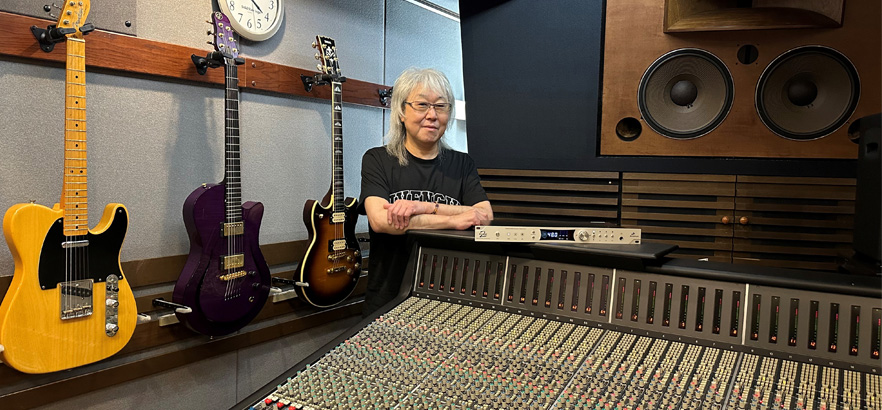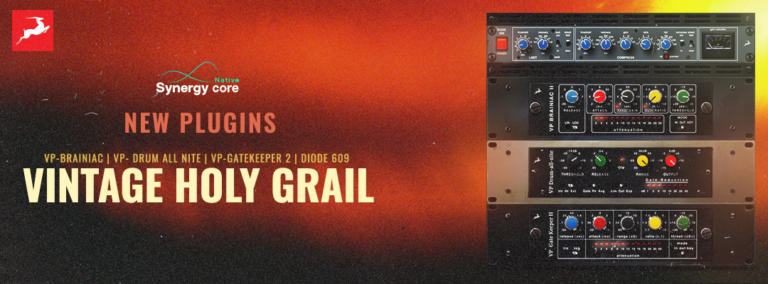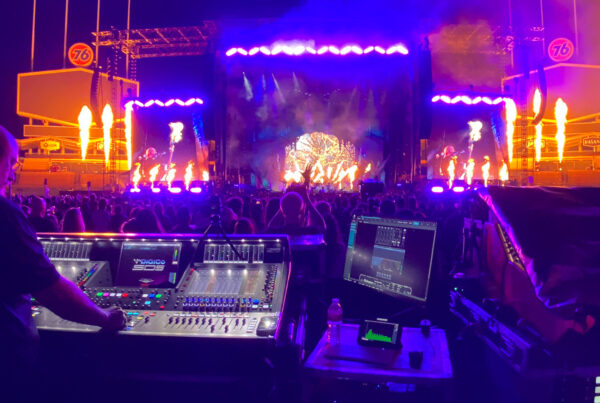Kenji Kawai, one of Japan’s leading composers, has been at the forefront of composing for animation, TV drama, commercials, video games and theatre since the 1980s – his work spans many genres and different media. We spoke to Kawai, an Antelope Audio user, about his equipment, his private facility AUBE STUDIO, and his work as a composer.
AUBE STUDIO is your own studio with an SSL 9000K as the main mixing console. Do you record and mix all of your productions here?
This is where I record my own guitar, percussion and other special instruments. When I need to record orchestras or groups, I take the basic tracks I have created at AUBE to an outside studio and do the overdubs there. Then I bring the recordings back to my own studio to mix.
Are you very particular about the equipment you choose for your own studio?
I use equipment recommended to me by people I trust, and I choose recording equipment with a reputation for high quality. I used to use a Sony PCM3348 [48-track 24-bit digital] tape recorder, and now I use Pro Tools. I use Pro Tools as a multitrack recorder and I mix on the SSL.
So you do all the mixing yourself?
I used to have an engineer do the mixing until about 2005 or 2006, but then I started doing it by myself. However, I still work with an external engineer when I record live ensembles such as orchestras.
You use the Pure2 Mastering AD/DA Converter from Antelope Audio. How do you use Pure2 in your workflow?
The multitrack digital audio from Pro Tools is converted to analog and mixed on the SSL, then I print the resulting analog stereo mix back to digital via the Pure2 AD converter, which I also use in my studio as a master clock.
Can you tell us why you chose Pure2?
Originally my mix engineer recommended dCS’s 902 AD converter [built in 1989] because it was so good at the time – but one day it broke down and I couldn’t get it fixed – so I replaced it with an Antelope Audio Eclipse 384. The Eclipse was very easy to use and I liked the sound. I knew that if I needed another converter in the future, I would prefer to use an Antelope Audio product, so I am currently using its successor, the Pure2.
We tried several converters from other manufacturers, but the Pure2 was the easiest to use in our studio in terms of functionality. Most importantly, we were able to replace the Eclipse without changing our high quality audio workflow. I also feel that Pure2 fits well into our studio environment. The routing is easy to understand and the convenience of the manual settings is very appealing to me.
Can you talk a little bit about the specifics of your work? When you compose, do you think about surround sound from the beginning, such as which surround channel should play which instruments?
Unless it is part of my brief as a composer, I rarely think about it, I basically leave it to the dubbing mixers for the movie or game [and send them my stems].
Where do you get the inspiration for your compositions?
I have to consider from the director’s point of view what they are trying to achieve with the movie. I respect the director or producer’s opinion more than my own personal view on the storyline, and adjust my music composition accordingly. I don’t usually watch movies or dramas myself, so the director will explain the brief in their own words, as I can’t use comparative movie music references. At home, I tend to watch TV variety shows and listen to Burt Bacharach.
Antelope Audio is a Bulgarian-based manufacturer, and I heard that the music for Ghost In The Shell was actually inspired by Bulgarian music.
Originally, the director said he wanted a drums-only score – without any ethnic flavor – but I found film music was difficult or impossible to express as percussion alone. I wondered if it would be possible to convey the sound of a taiko [drum] by replicating the timbre orchestrally… but if a real orchestra was used, then the characteristic drum tone would be obscured. I thought something simpler might be better.
At that time, Bulgarian vocal music was just starting to enter the Japanese market, and when we tried it on a simple taiko track, it sounded really cool, and the director liked it. I contacted the people responsible and asked if we could use the Bulgarian vocalists, but they refused, saying they’re folk singers, so they can’t sing what I had written in the score. While I was debating what to do, I had invited minyo (Japanese folk song) singers to provide musical accompaniment for another project, and I wondered if I could ask them to perform the score. Japanese folk songs do not have a form of harmony chorus, but I made a demo to try it out, and it was really cool. If we were going to do it in Japanese, why not use the old Yamato dialect? The result was Ghost In The Shell.
You also composed the music for the Hong Kong movie Ip Man. Can you tell us how you got involved in Hong Kong movies?
When ‘Innocence’ [Ghost in the Shell 2: Innocence, 2004] was nominated for the Cannes Film Festival, Hong Kong director Tsui Hark was on the board of judges, he became interested in my music, and eventually asked me to compose the music for the movie Seven Swords. [Actor] Donnie Yen was in that movie, and later he asked me to do the music for a movie he was starring in [and doing fight choreography for] called Dragon Tiger Gate, which became the second Hong Kong movie I was involved in. Donnie told me that he would do another film with a completely different story, and that was Ip Man.
Please tell us about any episodes in the productions so far that proved difficult for you to realize.
When we had the time and budget for ‘Innocence’ and the director wanted a music box, I actually made a music box disc. The music box machine itself is manufactured by a Japanese company called Sankyo Seiki (now Nidec Sankyo Corporation), but I had an original disc made, recorded in the studio, and then went to the Oya quarry in Tochigi Prefecture, installed many speakers, and played it loudly to record the natural reverb.
For the previous Ghost In The Shell, the three folk singers were dubbed five or six times each, but then the movie director asked me: “Can’t we have 100 people this time?” First of all, I wondered if there were even that many specialist folk singers – I didn’t think we could get that many – but in the end we managed to find 75 vocalists to sing together in the hall. The director told me later that he never thought we could actually do it!
Finally, do you have any advice for musicians who want to compose film music in the future?
I am not an artist. I consider myself an artisan. I am a composer who is asked by others to create something they desire. Of course there are people who are artists. But what I can say is, ultimately, it’s your own feelings determining what you should do, so I want you to trust your own judgment. In the end, you can only judge for yourself whether something is good or bad, so you have to trust your own sensibility.
I also want you to listen deeply to the music you like. I don’t want you to imitate this style, but to explore the underlying attraction of the music. I love Burt Bacharach’s music, so I look for the underlying appeal. I think that has a lot to do with my own sensibility. But there are times when that taste is wrong [laughs]. In that case – I apologize!

Kenji Kawai
Born in Tokyo in April 1957.
After working as a guitarist, he made his film debut with The Red Spectacles, directed by Mamoru Oshii. His major works include Ghost In The Shell, Ring, Death Note, Gantz, Seven Swords, Ip Man, Ranma 1/2, Mobile Police Patlabor, World Trigger, Resident Evil: Vendetta, Token Ranbu: Hanamaru and other animated TV series. He has also worked on TV dramas such as The Woman Of S.R.I., Burning Flower, Ultraman Geed, Kamen Rider Build, Manpuku and documentaries such as NHK Special Futto Toshi, Unsolved Cases, The Human Body: The Mysterious Huge Network and others. For overseas productions, he was in charge of the French documentary program Apocalypse -The Second World War, as well as the Hong Kong films Seven Swords, Ip Man and Limbo, and the co-production film A Battle Of Wits.









